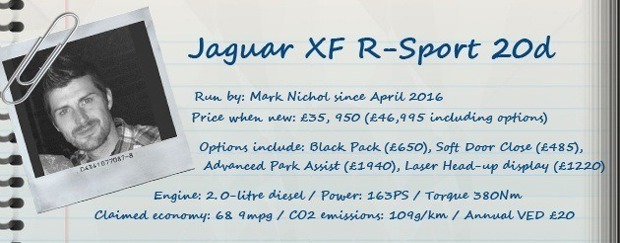Jaguar XF: Welcome, our sport
There's already so much love for Jaguar's new XF saloon that we thought we'd see if it justifies the hype over the long-term...

Date: 29 April 2016 | Current mileage: 6412 | Claimed economy: 68.9mpg | Actual economy: 43.9mpg
So here it is, family motoring upper middle management style. The last (and first) XF saloon was really the car that made everyone realise Jaguar had changed - we ran one, and loved it. This follow up version remains every inch the modern Jaguar, but it’s arguably also an anachronism.
That’s because with every new take on the posh SUV that comes out, the three-box executive saloon seems increasingly old hat. To put it in the language of the meeting room, maybe this is corporate streamlining in action: why tick three boxes when two will do?
Jaguar realises this, hence the new F-Pace, but clearly there’s no way the company is going to stop making big sporty saloons any time soon. Undoubtedly, though, what the F-Pace will do is make anyone that walks into a Jaguar dealership for an XF stop and think, “hang on a second…”
So the brand new XF (it went on sale September 2015) not only has the usual suspects to deal with these days (Mercedes-Benz E-Class, Audi A6, BMW 5 Series, Lexus GS and an Infiniti of some sort, possibly), but a newer and ever-expanding breed of premium hatchbacks of the SUV persuasion, including one that looks like its fat twin brother.
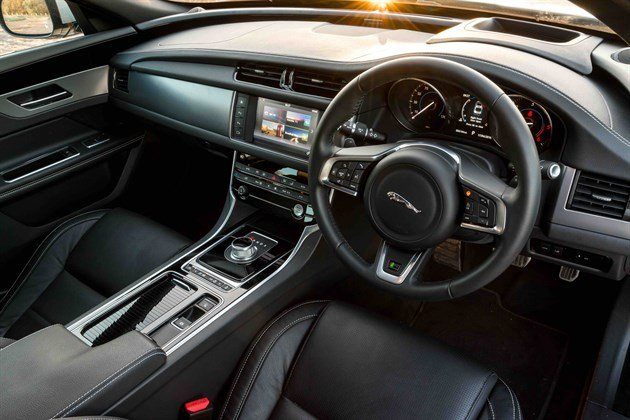
Our XF comes pretty much fully loaded. At a price...
Over the next six months we’ll be looking at the XF in the context of both those threats, as well as, basically, whether it’s up to scratch given its £47,000 price tag. That’s £46,995 to be precise, including options - our car is a mid-spec F-Sport model with a 163PS 2.0-litre diesel engine, priced at £35,950. And to be frank, the salary-wilting price tag after options is already putting the XF on the back foot.
I mean, imagine spending 48 grand on a car with a four-cylinder diesel engine under the bonnet, and not a very quick one at that? Just for some context, albeit not exactly like-for-like, just today Mercedes-Benz has announced that the new Mercedes-AMG C43 Saloon will cost £44,460 – all 367PS, 0-62mph in 4.4 seconds of it.
Of course, nobody jumps from a 68.9mpg diesel executive saloon to a 35.3mpg twin-turbo petrol one, not least because the former offers space, comfort and minimal tax liability, while the latter basically a very quick way to get to the disabled bay outside Wetherspoons. Still, the point stands: this XF is one very expensive ‘eco’ car.
That’s ‘eco’ in quotation marks because, as you can see above, we’re already a good 25mpg south of the XF’s claimed average consumption figure. I expect we’ll give plenty of time over to discussing the diesel engine over the next few months. That and its embarassing wheels. Lots to talk about then…
Should have gone to spec-savers?
Ever thought about ticking 'select all' on options tab of the car configurator? Strange things happen.
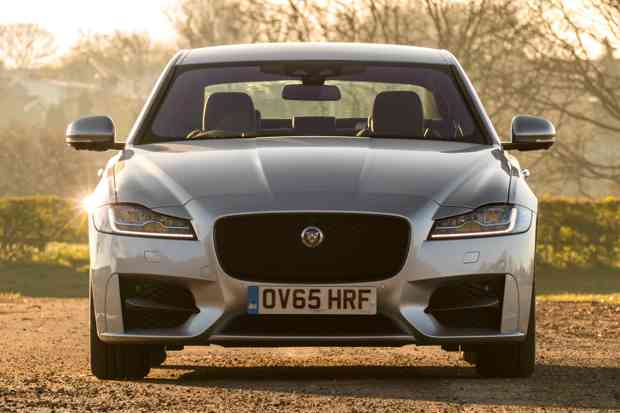
Date: 17 May 2016 | Current mileage: 6776 | Claimed economy: 65.7mpg | Actual economy: 43.9mpg
Consider the following list:
Honda Civic Type R: £97 per one horsepower (£30,000)
SEAT Mii S: £141 per one horsepower (£8,440)
Jaguar F-Type: £152 per one horsepower (£51,775)
BMW 520d: £185 per one horsepower (£35,315)
Ferrari California: £277 per one horsepower (£180,720)
If you’ve not already worked it out, that there is a list of how much each of those cars costs for each one of its metric horsepowers, based on price. So, where do you expect that our Jaguar XF would fit into that list? Between the F-Type and 520d, perhaps? Ok:
Our Jaguar XF: £288 per one horsepower (£46,995)
Yes, that’s more pounds per horsepower than a Ferrari. And almost as much as a Lamborghini Huracan LP610 at £296. Amazing, right? Now, before there’s a meltdown in Coventry, I should acknowledge that this is not a fair test – in fact, if you take away our car’s options, the number drops to £221 (£35,950), though that still puts it £36 higher per pony than a BMW 520d M Sport.
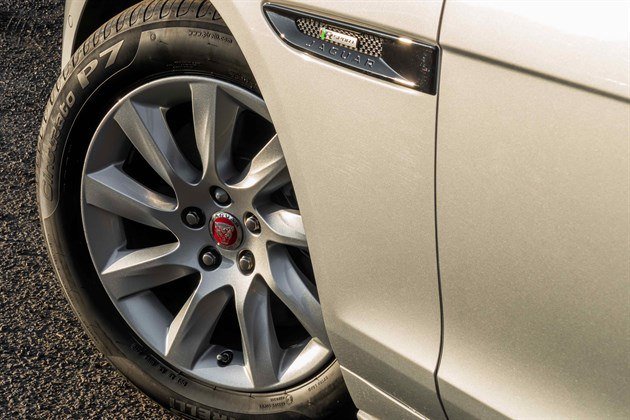
The above photograph has no sense of scale, so imagine a paracetamol placed on a round coaster
So why are we entertaining this vaguely ridiculous and certainly unscientific comparison? Well, it’s to get the notion across of a 163PS car that costs £47,000. Sure, plenty of cars with relatively low power can be specified to the hilt, but this just feels… well, lets just say that this XF, as lovely as it is, does not have the sort of brio that one might expect for one’s £50,000. It’s like discovering that The Terminator is asthmatic.
It’s all because the spec sheet includes 13 high-cost options, ranging from a £300 space saver spare wheel at the cheapest end to £1940 worth of Advanced Parking Assist with Surround Camera at the other. Between those things are a £1220 head-up display, £1125 of adaptive LED headlamps, £1000 remote central heating, some black exterior trim (£650), and most bafflingly, £485 to have the doors latch themselves. Assuming you’re able to close the door softly enough to make it work, which is more effort than simply closing the door.
There's more besides, but the point is this: surely there isn’t another 163PS XF on the road worth this much? And if there is, it can’t possibly be on 17-inch wheels. Hey ho, at least the ride quality is excellent (mostly), and we can legitimately tell people that each of our horses is more precious than a Prancing Horse.
Now, I'm off to practice my swing. My gentle door swing, that is. Actually, I might train my cat to do the job instead, then drive my cat around at all times and make a YouTube video of our adventures and call it Big Cat Little Cat...
Dis-Ingenium
Our Jaguar's diesel engine is returning nowhere near its claimed fuel economy, even though it's got a fancy name.
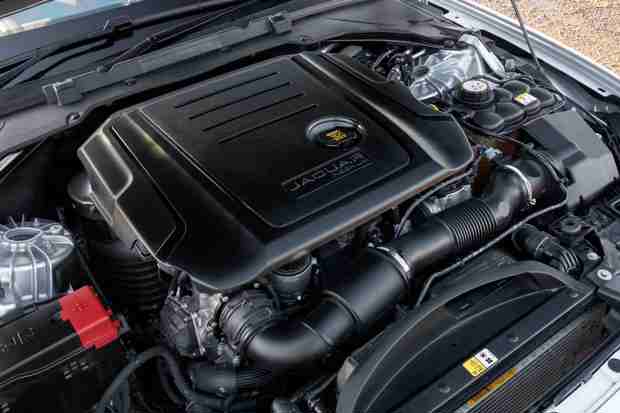
Date: 31 May 2016 | Current mileage: 7153 | Claimed economy: 65.7mpg | Actual economy: 38.8mpg
I like our Jaguar XF. I do. I like how it floats over stuff on its bouncy tyres, with their massive sidewalls. I like how the steering wheel is quite low-set and vertical, which is an ergonomic quirk specific to Jaguar. I like the rotary gear selector. And to be honest, I like how it feels having a Jag. It feels better than having a BMW or a Mercedes-Benz, because everybody has a BMW or a Mercedes-Benz.
I do not however, like this Jaguar’s engine. This Jaguar’s engine makes this Jaguar slow and noisy, yet it does not make this Jaguar very efficient. We’re currently returning 39mpg.
This Jaguar is powered by a 2.0-litre four-cylinder turbo diesel engine with 163PS. It’s part of a family of four-cylinder petrol and diesel engines developed from scratch by Jaguar and formally unveiled in 2014.
The idea is that they all have the same basic, modular aluminium block comprising four 500cc cylinders, with efforts to reduce weight, friction and complexity shared across all engines. Designed and produced in Jaguar’s £500m (and also new) engine plant in the West Midlands, the block is already in use across Jaguar and Land Rover products and will form the basis of Jaguar Land Rover engines for years to come.
It’s all great, tax efficient stuff on paper: the diesel in our XF returns a mere 109g/km with an automatic gearbox, and just 99g/km and 74.3mpg combined in the smaller, base model Jaguar XE with a manual.
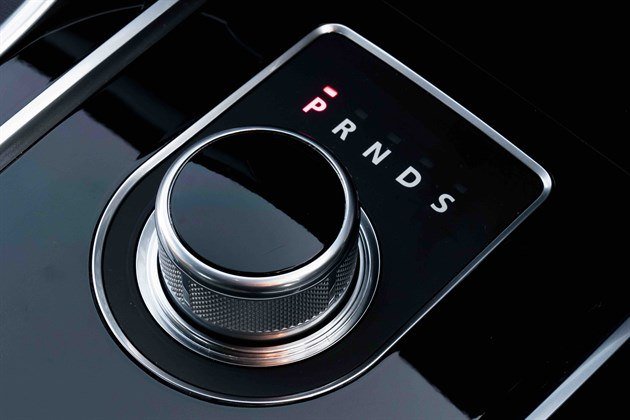
Turn to D for 39mpg...
It’s even got a name: Ingenium. It’s quite rare for a car manufacturer to bestow a sobriquet upon something as mundane as an engine block, but it’s actually a very smart move. It gives this - again, an engine block - a sense of personality and character and warmth. And, therefore, it elevates it above the RZ154-65830-2763.2b engine block that Manufacturer B uses for its diesels.
Ingenium is a made-up word that evokes ‘ingenious’. Fair enough. But it also evokes ‘disingenuous’. I’ve driven three cars with this engine (Jaguar XE, Land Rover Discovery Sport and this XF) and on each occasion it’s returned fuel efficiency way below its claimed average. All engines do, but this one seems especially short. And that’s not just my view – it’s your view too, as you’ll see if you look at Real MPG.
But it’s the more subjective stuff that’s bothering me most about the engine in this car at the moment. It has a lot of torque (380Nm at 1750rpm) so it’s a lot more suited to the XF than it probably should be, blessed only as it is with 163PS.
However it is, frankly, unacceptably noisy especially when it’s cold. It makes the sort of grumbly diesel din that you wouldn’t be that happy about in a mid-spec Skoda, let alone £47,000 worth of Jaguar. If it was returning 60mpg you might say fair enough...but at 39mpg?
I’ve got one hand in my pocket...
Mark keeps reaching low down and feeling something furry. Yet surprisingly he doesn't like it...
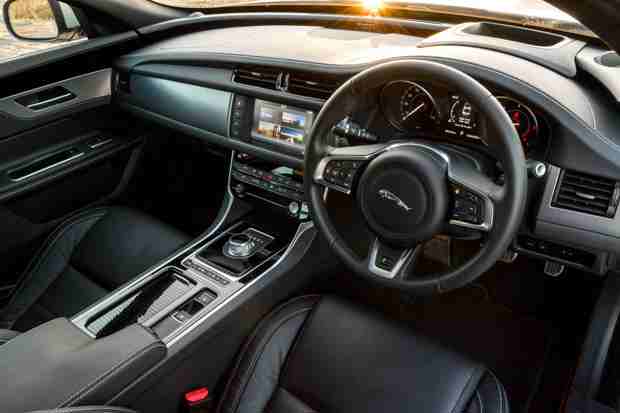
Date: 14 June 2016 | Current mileage: 7532 | Claimed economy: 65.7mpg | Actual economy: 40.5mpg
...and the other one fiddling with the sat nav. Classic Alanis. Anyway, today we’re going to talk about door pockets. Yes. It’s because the door pockets in our Jaguar are an excellent example of what’s wrong with this car. Well, not wrong as such, but just not what you’d expect.
I’ve been thinking a lot lately about perceived cabin quality – a lot more than I should be anyway, given there are many more important things to think about, like Brexit, or what would win in a fight between a Motorola RAZR and an iPhone 6 Plus. The Motorola would win – it would use its closing action like a Venus flytrap. Where were we? Door pockets, yes.
Whether car manufacturers admit it or not, when it comes to quality, car interiors are bound by a strange sort of convention. It’s a convention that says the best cars must have spongy plastic along the top of the dashboard and the door cards. It says the doors must make a certain sound when they close. It says that the seats must be bound in some sort of leather.
Why? Who really cares about the sound that a door makes? I’d be much happier if car doors shut with a comedy “CLANG!” like a giant frying pan hitting a cartoon character in the face. Also, who touches the top of their dashboard, apart from once simply to confirm that the top of the dashboard is spongy?
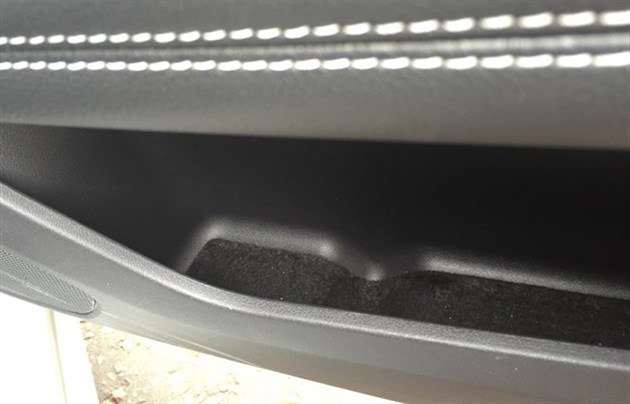
Fuzzy felt. Not just for primary school projects.
And who among us hasn’t felt the pain of getting into a car while wearing shorts on one of those (admittedly rare) summer days, only to immediately wish the chairs were not leather because sun has heated them to 500 degrees? “Argh! Jean, quick! What’s the postcode to the burns unit?”
The actual car experience, the day-to-day one, involves pulling the door handles, turning the heater dials, fannying on with the radio stations, finding a gap between the cupholders to squeeze your phone into, opening the glove box to see if you’ve lost your wallet in there, scrumpling up Drive-Thru receipts and putting them in the door pockets.
This is car ownership. For this reason, you want the door handles to feel great – heavy, substantial, smooth. You want the same from the glove box handle and the heater controls. You want the leather that's burning you to feel soft and supple and expensive. You want a proper place for your phone. And you want the door pocket that you’re stroking in order to find that missing expenses receipt to feel good too – like it deserves to be part of your £47,000 car in some way, at least.
The XF's leather feels like elbow skin. And its door pockets are worse. The XF’s door pockets are made from the same kind of brittle moulded plastic as a house phone. And they’re lined with felt. Yep, they’ve literally had a strip of fuzzy felt glued to the bottom of them, as though Jaguar had a school trip in on a factory visit and needed to give the kids something to do.
The XF might have a great chassis, striking design and fantastic ergonomics, but the little things...too many of them are not good enough.
The heebie-Ghiblis
A family car purchase makes us question the XF's place in the pantheon of executive saloons. Is it still the 'alternative' choice?
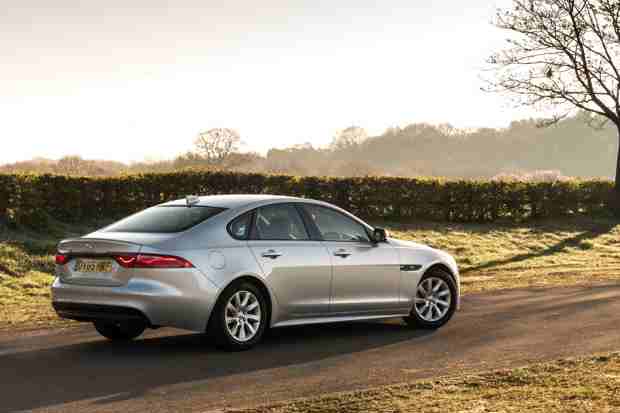
Date: 28 June 2016 | Current mileage: 7845 | Claimed economy: 65.7mpg | Actual economy: 41.4mpg
My dad is the most financially cautious person I know and not actually that into cars at all. Which makes it all the more strange that when it comes to his wheels he’s prone to two things: A) Buying them outright, and B) Changing them quite often.
His car is the chink in the armour that is his fiscal perspicacity. Because buying cars outright then changing them every couple of years is like investing in a bottle of rare wine, drinking half of it immediately then selling the rest in plastic shot glasses outside Vodka Revolution.
So a couple of months ago my dad started bringing up the car change conversation, on the pretence that the free servicing deal on his 7 Series was about to expire. So, rather than start paying for servicing, the logical thing to do is to replace the car. Of course.
Now, any motoring journalist knows that even though many will ask for advice on their forthcoming car purchase, the resulting advice is rarely taken. It’s well-established in psychology that most people seek 'facts' simply to have their pre-formed opinions and preferences affirmed, rather than their minds changed.
This was evident when I casually mentioned the Maserati Ghibli as a possible replacement for the 7 Series. My dad, a long-time admirer of the Quattroporte, had his interest instantly piqued by the possibility of an 'affordable' Maserati – and one so rare, in the north east of England at least (the nearest dealership is in Leeds), that he hadn’t even registered its existence.
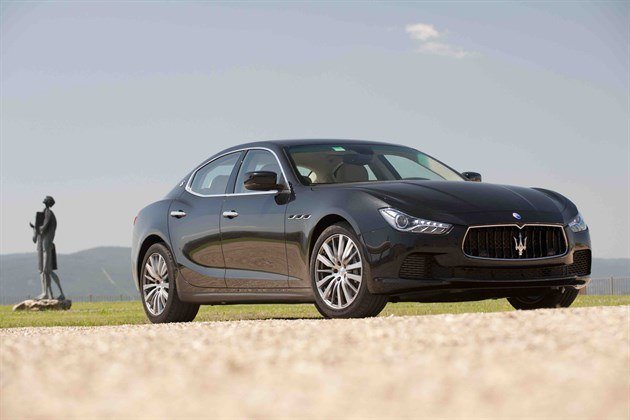
Maserati Ghibli: proper exotica for 'upper management four-door' money
And that was that. From then it didn’t matter that I implored him to test drive the latest Mercedes-Benz E-Class, on the basis that it’s the newest and best executive saloon on the market. It didn’t matter that an equivalently powered and specified BMW 5 Series would be more efficient, quicker, cheaper and probably better. It didn’t even matter that the Ghibli is pretty average. All that mattered was that a Maserati - any Maserati - had become accessible.
The Ghibli was bought. And then I realised something: it had never seriously occurred to me to recommend my XF. This could be in part because of the specification of our particular car, which gives it a highly unusual price-versus-power disparity, but it still wasn't something I really considered. And so, for a substantially lower outlay than our XF, my dad bought a six-month-old, genuinely exotic saloon packing much more power and infinitely more charisma - albeit not quite as much kit. (It doesn’t have DAB radio, which is insane in this day and age.)
Power and charisma, though - they're both qualities that any Jaguar should have by default, right? The XF is still leftfield compared to the 5 Series or E-Class, but the Ghibli made me realise that the XF is actually part of the establishment now. It's available as a low powered diesel and with tonnes of choice, in an attempt to offer the holy grail of big sales figures: something for everyone.
The problem is, being part of the establishment means you also have to be outstanding in every way to keep up – you can’t rely on charisma to cover your flaws. The XF is strong in many ways, but is it outstanding? The answer, I’m sorry to say, is no.
Bubble bobble
Click here to enjoy the greatest piece of Photoshop ever committed to a long-term test car update. Not even clickbait.
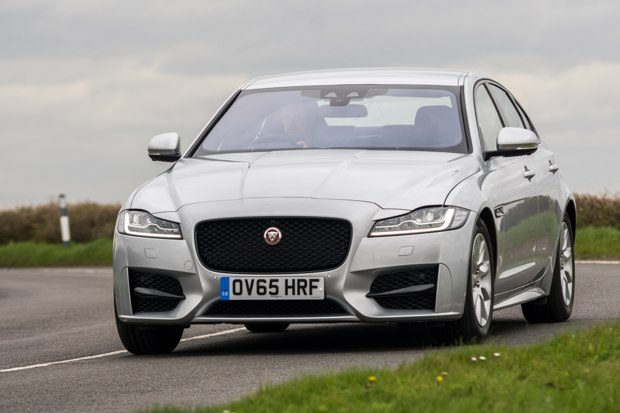
Date: 12 July 2016 | Current mileage: 8622 | Claimed economy: 65.7mpg | Actual economy: 42.5mpg
If the build quality of our Jaguar XF was poor I’d have been able to use the headline bubble and squeak, which is much better. Sadly, or fortunately rather, the XF’s build quality is brilliant. An abundance of hard plastic aside, the way this Jag is screwed together is more secure than Hilary Clinton’s personal email account. No squeaks, no rattles.
Instead we’re going with an obscure arcade game from the 1980s for the headline. The first part is because "bubbly" is how my next door neighbour described the wheels of our XF. Not bubbly as in ebullient or joyous, but bubbly as in ‘the bouncy-looking tyres overwhelm the little wheel in the middle.’ Like a Liquorice Allsort.
As it turns out, there are a couple of silver XFs in our town and my neighbour identifies mine by the "funny wheels", because the other XF has been specified with rims of requisite girth. Upon discovering this I found myself leaping to the defence of my inadequate alloys. Well, I say leaping…I totally agreed with her, but I felt somehow duty bound to justify why I’m packing such a below average inch count. I basically used the "it’s not the size of the boat…" defence. A classic.
The problem is that, as I’m personally certain is common when this particular defence is applied, the 'motion in the ocean' is a bit crap as well. Basically, the XF’s ride quality isn’t up to scratch.
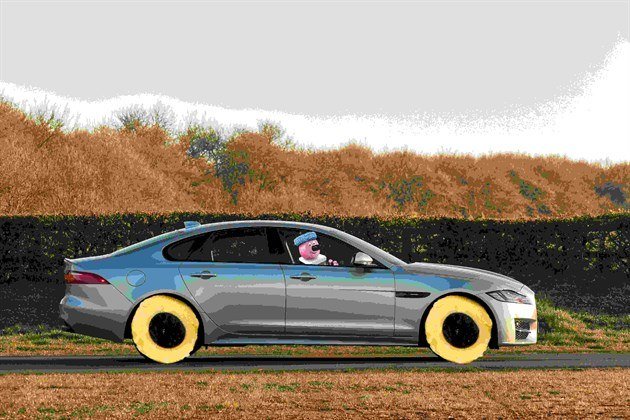
If you remember anything about this long-termer update, remember this...
The body control is excellent – the car generally glides over bumps with the gentlest bobble – but it still whams into potholes like George Michael into a Snappy Snaps. And, on occasion, it deals with less-than-even surfaces with all the composure of puppy on a bed of nails. Bubbly tires, bobbly ride. See. (Getting to paragraph five before the headline makes sense is a sure sign of a good headline.)
Is it calamitous? Nope. It’s just that at low speeds, when a Mercedes-Benz E-Class or an Audi A6 would be settled over the road, the Jaguar is being ‘sporty’. It would be ok if we were rolling on twenties wrapped in cassette tape, but because the tyres are thicker than Joey Essex it’s basically an inflammatory situation.
Still, 109g/km makes it better, and even though our fuel economy is disappointingly close to 40mpg, that’s only disappointing in the context of the official figures, which have little to do with anything.
The other thing to note is just how good a long distance car this is. All of our XF’s flaws come out around town: the ride quality on pothole-ridden roads, the rattling din of the diesel above 2500rpm, the distinct lack of pace. But at a nice steady 70mph – or more likely, an exact 50mph through some road works – the XF shines. Smooth road, eighth gear, packet of Liqourice Allsorts, bosh.
Jaguar XF makes the Biscuit
The XF gets to be a wedding car - but it isn't as quiet as a big, posh, smooth car should be.

Date: 26 July 2016 | Current mileage: 8950 | Claimed economy: 65.7mpg | Actual economy: 41.5mpg
The inevitable happened. The Jag became a wedding car, taking the lovely Rachel to Newcastle’s Biscuit Factory for the sort of trendy wedding that I wish was possible when I got married.
Things were learned. Firstly, I learned that having to drive a bride and her father somewhere on the biggest day of her life doesn't half shine a spotlight on things: propriety, personal hygiene. The usual stuff.
Mainly though, the spotlight glares incandescently on your very ability to drive a car and, it follows, the car itself. Turns out I’m probably not cut out for being a chauffer, what with my penchant for asking the client – the bride – whether I’m going the right way. Immediately followed by a sharp turn the right way.
There’s the smooth braking too, which is all good until braking becomes so smooth and gentle that people on scooters in traffic queues ahead are in genuine danger. The car handled things a lot better, firstly by providing ample space for knees, pointy shoes and long lengths of exquisitely embroidered fabric. Enough about my getup though - the bride got her dress in ok too. ZING!
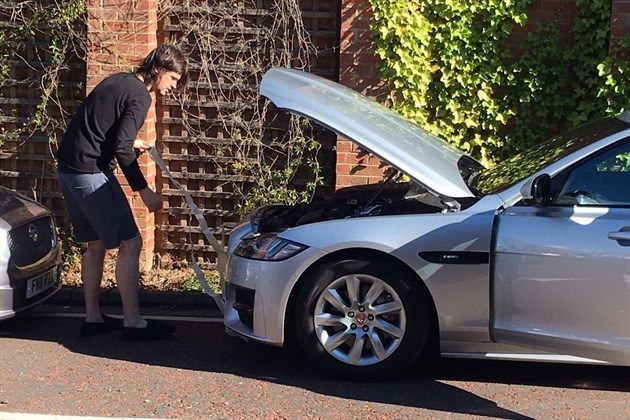
Yes, I'm wearing slippers outside. Like a mentalist.
The Jag's gearbox shifted from cog-to-cog in the style of a pint of John Smith’s: smooth, no-nonsense. A more relaxed driving style seemed to suit the suspension too. Fewer surprises meant less cabin turbulence.
But it’s still the noise that’s the XF’s undoing. Firstly the tyres – it hadn’t occurred to me how much tyre noise there was until I really started paying attention. (Note to self: delete this if ever applying for a proper Road Test Editor job.)
But, as usual, it was the engine that took centre stage. This 2.0-litre 163PS diesel really is the dirty big hair pulled out of the shepherd’s pie that is our wholesome British saloon. As I listened to it, its industrial din amplified by the circumstance we were in, not only was I slightly disturbed on behalf of my VIP passengers, but I realised something: I think Jaguar’s tried to make it sound like a six-cylinder.
Could be wrong, but there’s really no need for it to be this noisy. Surely Jaguar could have tempered it significantly more? And so I wondered, as we rattled towards the Biscuit Factory… maybe Jaguar has done this on purpose? Maybe it’s loud so that the untrained ear will think it more powerful than it is? I might ask someone who knows someone who knows.
Check out this one weird tip for selling a car
Sportiness. What does that even mean? And whatever it means, is it a good thing on a big, luxury car?
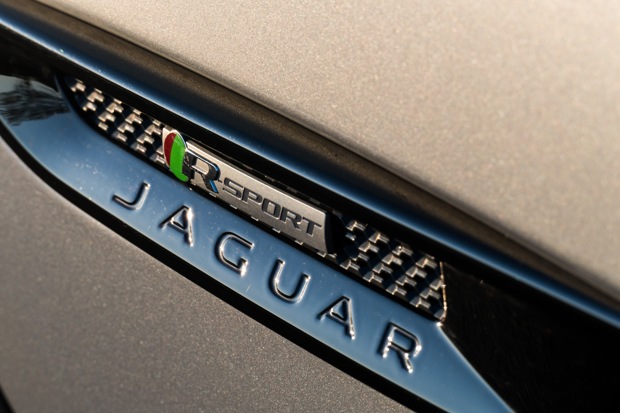
Date: 2 August 2016 | Current mileage: 9,550 | Claimed economy: 65.7mpg | Actual economy: 43mpg
Sport. Car manufacturers love the word 'sport'. Why? A car, any car, is about as linked to sport as Donald Trump is to the feminist movement. A certain type of person might immediately jump to the motorsport defense: “ooh, the carbon fibre tub of a McLaren 570S is directly linked to Formula One.”
Brilliant. When McLarens come down to the £2K mark I’ll be sure to mention that when I’m updating my Facebook status after buying one.
Meanwhile, the relationship between sport and the cars we buy remains largely marketing based. It’s a word that evokes activity, involvement, engagement, health… all aspirational things that feel nice when you’re thinking about them on the settee during the ad breaks. With your big Kit-Kat.
What it usually means in reality is an extra inch on the wheels, a front bumper that’s been re-moulded slightly, some cloth with a different pattern and a couple of badges. Voila! Well not quite. Because the other thing about sport is firm suspension – in our Jag’s particular case a ‘Sport Suspension Upgrade’. And that means a jiggy car. And not in a good, Will Smith sort of way.
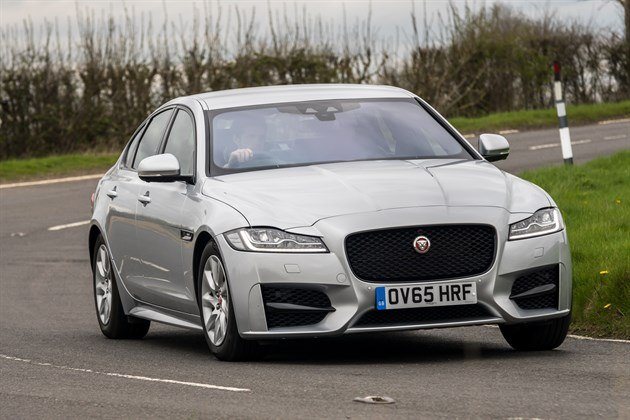
XF being sporty an' tin.
So our XF is hit with a double whammy of sport. There’s the fact that Jaguar has played to its heritage by making the XF fundamentally focused on driver involvement (shorthand = 'sporty'), and then there’s the R-Sport trim level that adds another layer.
Now, this might sell more cars (I don't know, but I'm sure a marketing person can make up some numbers to show that it does) but for me, Jaguar is making the mistake that Audi used to with its S Line stuff. Buy a last generation, pre-facelift Audi A4 S Line on big wheels and you’ll be shaken senseless. So senseless, evidently, that you’ll genuinely believe that your 2.0 TDI is the fastest thing on four wheels.
You should get into a Jag saloon and be comforted, relaxed, soothed, cosseted… all those words that we road testers trot out when a car is nice and serene. By all means make the XF a bit fun, but mainly, make it ride like its occupants are both very important and completely knackered. Our Jag is far from uncomfortable, but it's also out-wafted by the Audi A6, the Mercedes-Benz E-Class and the BMW 5 Series. That shouldn't be happening.
Oh, and "R Sport". Think about a place you might park your backside then say it again. Sorry.
Jaguar XF: old or new?
The new XF feels so similar to the old one that you might as well save some money and buy used...right?

Date: 16 August 2016 | Current mileage: 9,892 | Claimed economy: 65.7mpg | Actual economy: 43mpg
This Jaguar XF looks so similar to its predecessor that it raises the question why bother buying new? I know that all successor cars look quite similar to their antecedent – well, most of them anyway – but I honestly think that a lot of people don’t care enough to really see the difference.
Call it a “strong aesthetic” if you like, but the familiar styling of the latest XF has given the old one a particular longevity; if you buy a later first generation XF, a facelifted one, you’re buying a great value car that still looks fresh, inside and out.
Check this out. The original XF came in 2007 and was updated in 2011. In 2012 you could buy a new XF diesel S for around £50,000 – a car with 600Nm of torque and ergo quicker than peak Billy Connolly. That’s not far off the list price of our car today (albeit ours has options) – a car slower than peak Joey Essex.
Today, you can buy the 2012 car for somewhere around the £18,000 mark – a good one at that, in nice nick, with a full service history and reasonable mileage. And honestly, given the choice, it’s what I’d do. I know that it’s not a choice for many (company car drivers etc.), but if you’re a cash buyer, it’s tempting.

This gear selector is slightly offset in the last gen XF. Other than that...
In 2012, our David ran a last generation XF and generally loved it – the styling, uniqueness of the interior, comforting quality of the ride, and general sense of being a cat among the German pigeons all made it a compelling executive car. The fact it was so very game changing for Jaguar helped at the time too.
What’s happened – perhaps inevitably – is that where the first XF was a giant leap forward, its replacement is a small step. It probably couldn’t have been much else, short of becoming a hatchback or something, but the other problem it has is that the completion has, by and large, made big leaps.
The new Mercedes-Benz E-Class is a mesmerising car, perfectly bland on the outside but sumptuous inside and packed with the sort of useful technology and comforts that will keep an owner happy for years; the 5 Series is on the cusp of being replaced, but the current one still looks every bit as fresh as this latest XF – fresher, in my opinion.
So yes, the latest XF is a really good car in many ways, but I can’t help thinking that it just hasn’t moved on enough from the last one.
Backing out of the R-Sport
The Jaguar XF is off. Let’s talk about what it’s been like and, crucially, whether we’ll miss it.
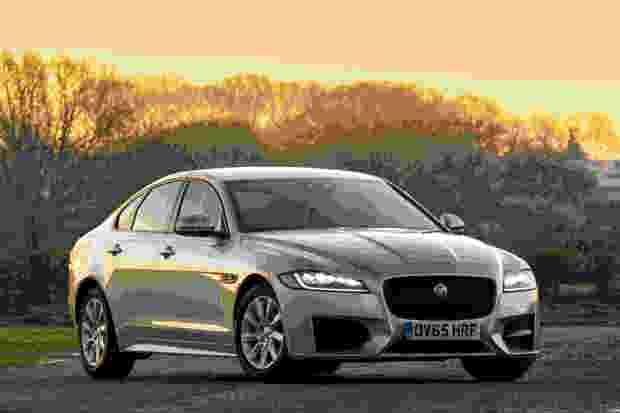
Date: 27 August 2016 | Current mileage: 10,552 | Claimed economy: 65.7mpg | Actual economy: 49.2mpg
Bye then. The Jaguar is off. Let’s talk about what it’s been like and, crucially, whether we’ll miss it. The short answer can be boiled down to a confused emoji. The slightly longer answer is that we’ll miss having a Jaguar, but we won’t miss this particular Jaguar. The even longer answer goes a little something like this…
It’s a bit shallow to admit that you’ll miss having a Jaguar, but it says something about the power of the brand that you can fail to connect with a particular car but nonetheless really enjoy owning it. The history of the brand, its Britishness and its place as a very slightly off-centre alternative to the German stuff all combine to make Jaguar ownership a fairly special thing. We’ll miss that.
But this XF…not so much. And it’s simply because the trio of German executive saloon alternatives are each staggeringly good. The Mercedes-Benz E-Class stands tall as a bastion of high-tech luxuriousness; the Audi A6 set a high watermark in refinement and continues to set the standard for cabin quality; the elderly BMW 5 Series still looks and feels splendid in every way.
The XF simply falls short in too many ways. The cabin already looks dated and the lower level plastic quality isn’t good enough. The infotainment screen is too small. The leather is too rough. But the main thing is the 2.0-litre diesel engine, which has all the tonal nuance of a Sex Pistols album. Comparing it with the latest four-cylinder diesel in the E-Class, for example, is like comparing a campsite generator to a musical mobile for cots.
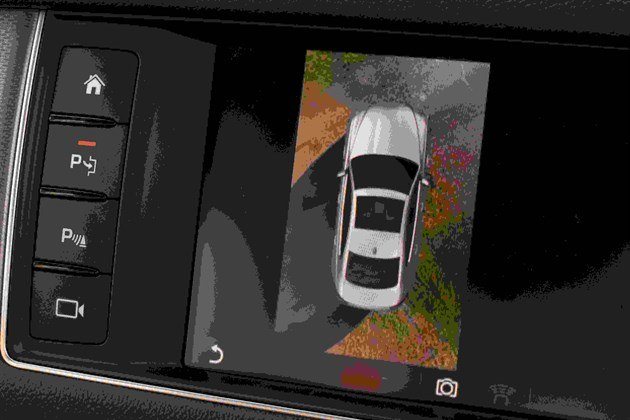
Jaguar has a drone follow every XF fitted with top-down parking. That's the only explanation for it.
However, the last couple of months with the XF have been spent mostly on the motorway, and slowly but surely this particular combination of small diesel engine and big British saloon has started to make sense. It’s here that this XF is most comfortable – sat at 70mph in eighth gear. And you’ll note, if you’ve followed the other updates, that the average MPG has jumped up significantly. That’s because we’ve been enjoying regular 50mpg+ runs between Newcastle and Peterborough. The glamour.
On the motorway, in top gear, the engine quietens down and suspension that feels over-firm around the streets keeps the car lovely and stable. The driving position, low and near-perfectly executed, means there’s no discomfort. And on the motorway especially, that the fact that the arm rest in the door and the centre console are at exactly the same height – elbow resting height – becomes a gift. As do the tiny wheels and bouncy, bump alleviating tyres.
So, in conclusion, if you’re going to do a lot of motorway miles, don’t care about accelerating up to 70mph especially quickly, don’t care for massive wheels, don’t go mad with the options list, and don’t want to be another German saloon owner, there’s much to recommend in a base model XF. And in the words of everybody's favourite shrimp boat owner, that's all I have to say about that.
Oh, one more thing... I've now owned an XF for six months and I still can't tell the difference between it and a cheaper, smaller XE when I see one.


